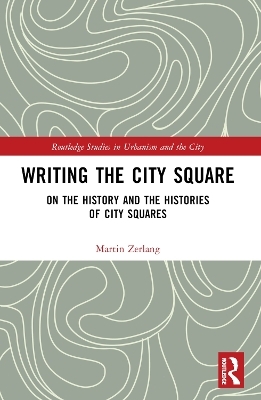
Writing the City Square
Routledge (Verlag)
978-1-032-37202-0 (ISBN)
The history of cities is also the history of city squares. The agora, the forum, the piazza, the plaza: All presuppose the idea of a center. It’s a material and mental phenomenon. Literature is an important part of this history, and the interplay between the square as physical space and the square as literature is the topic of this book.
This is an encyclopedic book combining an overview of the history of city squares with a plethora of analytical examples of its reflection in literature: Literature uses the city square as a frame; city squares serve as frames for drama; novels and other kinds of literature comment on city squares; city squares are sources of inspiration for all sorts of literary activities. Socrates in the agora, Cicero in the Forum, Calderón in the Plaza Mayor, Corneille in the Place Royale, Richardson in Grosvenor Square, James in Washington Square, Woolf in Bloomsbury Square, Döblin and Gröschner in Alexanderplatz, Rodoreda in Diamond Square in Barcelona, DeLillo in Times Square, Al Aswany in Tahrir Square, the Maidanistas in the Maidan of Kyiv: These are just some of the examples presented and analyzed in this book.
The book is of direct interest for researchers, students, and professionals such as architects and urban planners, but it is written in a way that makes it accessible for all readers with an interest in urban culture, architecture, history, literature, and cultural studies.
Martin Zerlang is a full professor of literature and modern culture at the University of Copenhagen. During the last 15 years, he – together with architects and other urbanists – has participated in a number of architectural competitions and taken first prize in three of these. He has edited a collection of essays on Representing London, and has published articles in English on the Tivoli Gardens, the New York World Exposition 1853, and Israels Plads, a city square in Copenhagen. He has published several books on urban culture and urban literature, among these Zoom København (2017) and books on the bicycle (2018), the car (2021), and the train (2023) in Danish culture.
Introduction PART I: GENERAL OBSERVATIONS 1: Words on the square; 2: The mediated square; 3: Shapes and forms; 4: Doves and dances PART II: HISTORICAL TYPES 5: The Agora; 6: Forum Romanum; 7: Medieval Marketplace; 8: The piazza; 9: The plaza; 10: The Place Royale; 11: The residential square; 12: The Crescent in Bath PART III: REPRESENTING MODERN SQUARES 13: Place de la Concorde; 14: Between demonization and domestication; 15: Squares in European literature; 16: Squares in Latin American literature; 17: The American Corner PART IV: PLANNERS AND MODERNIZATION 18: Ildefonso Cerdà and Barcelona; 19: Charles Buls and Brussels; 20: Camillo Sitte and Vienna PART V: TRENDS IN THE 20th CENTURY 21: Modernism; 22: Communism; 23: Consumerism PART VI: THE POLITICAL SQUARE 24: The Arab square; 25: Maidan and Maidanistas; Concluding Words
| Erscheinungsdatum | 14.04.2023 |
|---|---|
| Reihe/Serie | Routledge Studies in Urbanism and the City |
| Verlagsort | London |
| Sprache | englisch |
| Maße | 156 x 234 mm |
| Gewicht | 460 g |
| Themenwelt | Naturwissenschaften ► Geowissenschaften ► Geografie / Kartografie |
| Sozialwissenschaften ► Soziologie ► Makrosoziologie | |
| Technik ► Architektur | |
| ISBN-10 | 1-032-37202-8 / 1032372028 |
| ISBN-13 | 978-1-032-37202-0 / 9781032372020 |
| Zustand | Neuware |
| Informationen gemäß Produktsicherheitsverordnung (GPSR) | |
| Haben Sie eine Frage zum Produkt? |
aus dem Bereich


